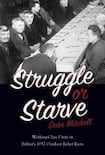
“On the Shankill Road crowds of growling men lounged around waiting. Suddenly a big red-faced woman […] appeared from nowhere. She shouted, ‘They are kicking the shite out of the peelers [police] up the Falls. Are you going to let them down?’ ”
This eyewitness glimpse of Belfast in October 1932 is significant for more than its fresh language. The notion that 'growling' men on the city's Protestant-dominated Shankill Road would hasten to the aid of Catholics fighting the police a short distance away on the Falls Road seems vanishingly improbable, then as now. Yet the premise of Seán Mitchell's fascinating Struggle or Starve: Working-Class Unity in Belfast's 1932 Outdoor Relief Riots is that a class-based politics did exist, and even for a short time flourished, on the streets of a notoriously sectarian city.
Belfast was and remains no stranger to street violence, but the so-called Relief Riots, which electrified the city in autumn 1932, were of an altogether different order, and Mitchell explains their broader context in exemplary fashion. Working-class communities required relief from the recession that had gripped the world in the aftermath of the Wall Street Crash of 1929, but such welfare as existed in Northern Ireland those days remained grounded in the Victorian Poor Laws, described by Mitchell as “an institutionalised form of class control”, and influenced by the notion that the deprived were merely feckless. Financial relief was niggardly, with many destitute workers denied any form of welfare.
They would be looked after by the state, but the reality was very different
In addition, the economy of the infant Northern Ireland was already struggling. The Belfast mills and shipyards, which once exported to the world, were ill-equipped to deal with global competition, and by the early 1930s unemployment was spiralling within working-class communities.
No solutions
Given that Northern Ireland was explicitly “a Protestant land for a Protestant people,” it came as a profound shock to working-class Protestants that the province’s unionist establishment could offer no solutions. “Protestants were told,” remarks Mitchell, “that they would be looked after by the state, but the reality was very different.”
Matters would come abruptly to a crisis, and this crisis would briefly entwine working-class Protestant and Catholic interests and unite these communities in an unprecedented way.
On October 3rd, 1932, thousands of workers, Catholic and Protestant, went on strike across Belfast, and that evening a crowd at least 60,000-strong packed the streets in front of City Hall to listen to speakers from communist, nationalist, unionist and Labour Party backgrounds lay out their demands for welfare and a living wage. “Let our slogan be,” declared one speaker, “no surrender to poverty, misery and destitution.”
Northern Ireland has always, of course, been a politically more nuanced place than the sectarian basket case of popular lore, and in this context, the response of middle-class Catholics, and of the Catholic Church, is most revealing. The Irish News fretted that the strike would have to be dealt with properly, for fear of its effects on the businesses of professional Catholics, whose attitude to the new Northern Ireland offered a masterclass in ambivalence.
In the end, the relief riots were crushed, and indeed, the sectarian card was played ruthlessly
Their church, meanwhile, denounced the “red menace” of communism that appeared to be spreading across the province. The rise of Bolshevism in Ireland, declared Joseph MacRory, the Catholic Archbishop of Armagh, “was the great apostasy which the apostle said would presage the end of the world”. Catholic workers on the picket lines, it was clear, were on their own.
Sectarian card
In the end, the relief riots were crushed, and indeed, the sectarian card was played ruthlessly: the Northern Irish prime minister, Lord Craigavon, conjured the spectre of republican infiltrators using the riots for their own ends: “Just one word, and one word only […] to those mischief-makers who have come into our midst. If they have designs by the trouble which they have brought into our city, if they have the idea at the backs of the minds that this is one way of securing a Republic for all of Ireland […] then I say with you – Never.” In fact, the IRA played little part in the movement.
Mitchell is wise enough to claim no great results from the relief riots, heady though they were: their challenge to the established order, he writes, was “limited”. Ordinary business soon resumed: as early as 1935, in fact, savage sectarian rioting would drive thousands of Belfast Catholics from their homes. If anything, this book emphasises how deeply sectarianism is scored across the face of Northern Ireland – indeed, it is stamped balefully into the form of the political structures at Stormont today. Yet the ultimate message of this timely and absorbing book – that a class-based politics has operated in Northern Ireland, and thus might operate again – is in itself a useful reminder that the past can, given half a chance, offer lessons for the future.











